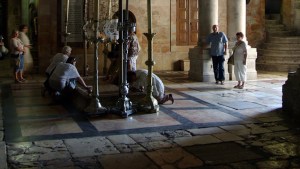Among the most moving sights visitors encounter at Jerusalem’s Church of the Holy Sepulchre are the thousands of crosses etched into the church’s walls. They serve as reminders that today’s pilgrim follows in the footsteps of Christians, who centuries ago, crossed continents to see the site of Jesus’ crucifixion and tomb.
More than just graffiti
Until now the markings were thought to be graffiti made by the pilgrims themselves. Now, as Reuters reports, Israeli researchers using three-dimensional imaging technology have determined that the crosses were part of a more organized effort.
Researchers found that the crosses, which they dated back to the 15th century, were very similar in terms of their depth and design. This suggests that they were created by only a few people.
Amit Re’em, an archaeologist working with Israel’s Antiquities Authority in coordination with the Armenian Orthodox Church, explained the team’s findings to Reuters.
“This unique phenomenon always baffled us: Is it graffiti of the pilgrims, or rather, something else?…,” said Re’em.
“We saw that all of them (crosses) have the same depth and even the marking of the mason,” he said, provisionally dating them to the 15th century.
“Maybe two or three hand artists made these crosses,” Re’em said. “…So it’s not graffiti, it’s something more organized.”
A special cross by a special artist
The limited number of artists indicates that the crosses were created as a service to the pilgrims, perhaps to aid them in their spiritual journey.
“Let’s say that you are an Armenian pilgrim, so you pay something to the priest, you pay something to this special artist and he carved for you, for the benefit of your soul and your relatives’ souls, …a special cross in the most sacred place for Christianity on earth,” Re’em said.
After closing last year due to the COVID-19 pandemic, the Church of the Holy Sepulchre opened for Easter, and is once again welcoming visitors.



